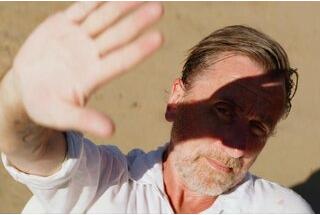Cinematographer Eben Bolter, BSC, talks about his work on “The Last of Us” serie
20 Years Later, by François ReumontWhen the world as you knew it no longer exists, when the line between good and evil has blurred, when death manifests itself on a daily basis, how far would you go to survive ? For Joel, survival is a daily concern that he manages in his own way. But when his path crosses Ellie’s, their journey through what remains of the United States will test their humanity and their will to survive.
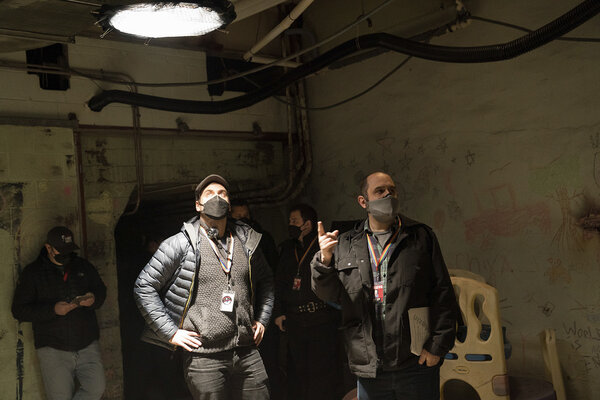
How did you come to be involved on this project ?
Eben Bolter : Well, it began a few years back. I remember quite well when I discovered the game when it was released in 2013. Several friends at the time had lauded its very visual aspect— almost cinematographic—and I’ll admit it was the first time that I found myself saying "wow !" while playing a video game. The guys who made that thing should be making films !
The quality of the production, the narration, and the depth of the characters were so great that I was really moved as a filmmaker. I was really impressed by their amazing work. In the meantime, my career as a director of photography progressed, particularly when I was chosen to shoot several HBO series (Avenue 5, The Girl Before, Inter Alia). At that time, I heard that Craig Mazin had signed on to make an adaptation of this very game ! As I had already had my bit of experience with the channel, I said to myself that I absolutely had to try to meet him to try my luck. That’s when I discussed it with my agent and I explained to her what a dream it would be for me to be a part of this adaptation… and, as though it were a dream, she got me an interview with the producers. The situation was as follows : the director and the cinematographer of the first two episodes had both already been chosen, and, indeed, the channel was looking for someone to shoot the rest of it, and even with options for the future because at that point, they didn’t yet know exactly how many more directors would be across the 9 episodes. I remember the interview having gone very well. They chose me as the cinematographer for the second and fourth blocks. I was also able to go straight to Canada and join block 1 for their prep. Then, I got to DP episodes 3-5 myself. All in all, I was employed for 11 months, and I also took care of the additional photography for several episodes, especially the travelling shots in the snow for episode 6. That was really a unique experience.
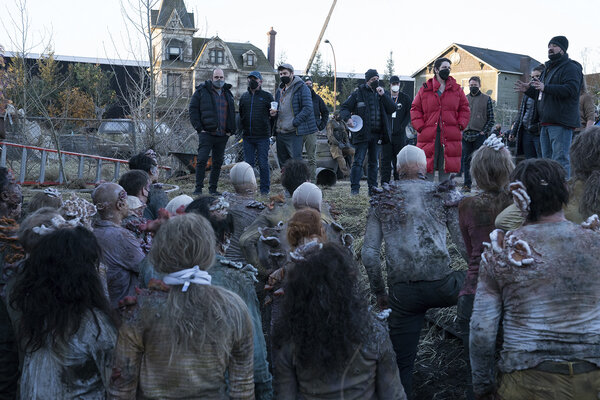
Although the series is faithful to the codes of the horror movie, it does take many liberties with the genre…
EB : One of Craig’s decisions was to consciously distance himself from the ambitions and the form of a classical television series. One of the ways he did that was by hiring directors and cinematographers who came from independent film. He believed they’d be able to take more risks than veterans of series. It was truly exciting for us. You must realize, being able to work alongside the showrunner and the director, constantly trying to come up with good ideas, is so much more motivating than when you arrive on a project and you’re asked to exactly copy the pilot episode. From that perspective, Craig and HBO truly gave us free rein on a lot of decisions : we were free to interpret the world of the video game as adapted by the screenplay, and, above all, we were free to take as-many risks as we wished. For example, they never shied away from dark scenes or from handheld- camera, which we used to shoot almost the entire series. Of course, we had huge financial resources at our disposal, and a huge crew, but on every scene, we tried to identify what was right for the story. That means that sometimes we just used one or two cameras, a quick setup and a super fast shoot, as though we were broke. Other times, we brought out the big guns on an exterior night scene shot on a 2,500-foot-long backlot, with buckets of special effects and extras. Each block had its own art supervisor, as well, so within the art department they could ensure continuity across the series but also have a single person per episode giving it their full attention. I remember that with each new episode, we felt like we were shooting a new film.
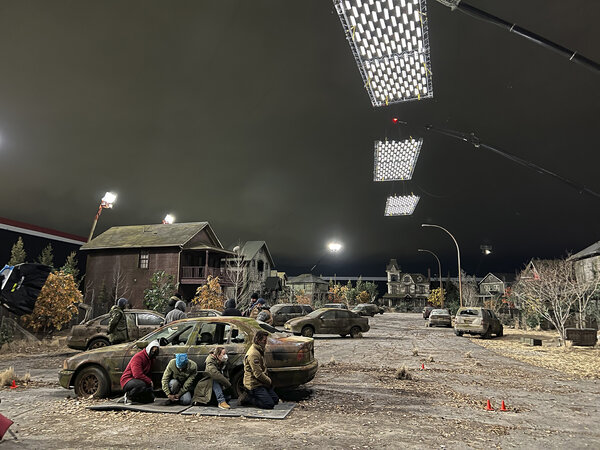
Episode 3 is certainly the first major surprise when first watching the series.
EB : It was such a shock for me to read episode 3 on paper ! The quality of the writing really shed light on the simple and authentic love story, such as one rarely encounters in this genre. That’s why Peter Hoar, the director with whom I worked on this episode, and I immediately felt we had a great responsibility on our shoulders. We felt it was absolutely necessary to do justice to the screenplay by giving our all in order for the love story to feel like an organic part of this world. One of the issues we had to confront was the passage of time. This element recurs throughout the series, such as the 20-year jump forward in time in which the writers decided to set the main narrative. The idea of returning to a world that has been suddenly blocked by the epidemic, and then seeing the effects of nature and age on everything manmade is visually very striking. A universe in which shopping centers have become museums - as in episode 7 - and where cities and highways have been overtaken by nature. From episode 3, we knew that we were going to have to portray a 16-year period on screen within the course of that episode. Our main concern was getting right the distribution of the passage of time on screen over the course of the episode.
This episode was shot over 23 days, near Calgary, mainly on a vast field where we built the small American town that becomes Bill’s private property. The interiors of the house were shot in studio. Because we had to use certain seasons as a visual marker as the narration progressed, the producers, the assistant director, and we chose to shoot those 23 days in the late summer of our shooting schedule for the series. This equinox period allowed us to get some really summery footage (which could also have been evocative of springtime), and also some more autumnal stuff when the leaves started to fall. Our pre-production work was very intense as we decided scene-by-scene exactly where we were falling within that 16-year period, and what colors and ambience we’d chose for each one. It was extremely exciting to be empowered to place the cursor anywhere we liked just in order to be able to tell this love story.
In this episode, there is also the scene where Bill, Franck, Tess, and Joel spend an afternoon together… You suddenly feel like you’re back in the old days…
EB : This is a scene that was shot - for reasons related to the shooting schedule - even before episode 2 had been wrapped. But, we assumed, on the basis of the screenplay, how moving it would be to see Tess reappear on screen... My memory of that scene is that it was really very relaxed and pleasant to shoot. A bit of an enchanted parenthesis, like in the series itself. It was obviously very heartwarming to be able to bring the four characters together, especially since their lines are humorous. As for the springtime atmosphere, again, it’s something we’d considered well in advance. It was thanks to the remarkable work of our first assistant director that we managed to juggle things on location by planning several possibilities for scenes almost every day depending on what the weather was like.
Did you play with certain parameters when shooting, such as a change in lenses on these scenes ?
EB : No, the work was entirely focused on what was in front of the camera : clearly depicted changes in season, the wind, the rain, and of course the night or the day. I felt that was quite enough, and we didn’t have to add another concept. I could give the example of the strawberry scene, which is an emotional climax for the characters of Bill and Frank, and we decided intentionally to set it at sunset. That might sound a bit cliché, but at that point in the film, it fit perfectly.
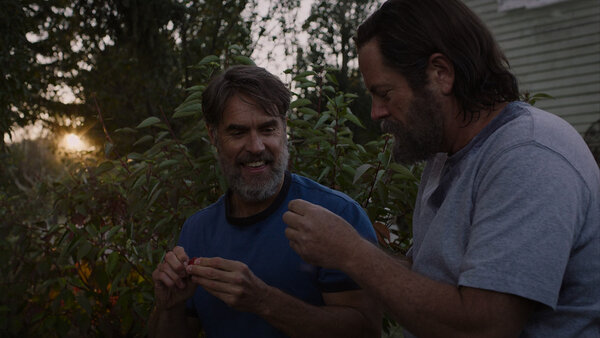
In fact, I realize that we were guided by two keywords from the start : simplicity and authenticity. That even applies to the choice of equipment : the entire series was shot on an Alexa Mini with a simple Cooke S4 series. We immediately set aside large format in order to give the images sufficient depth of field : the backgrounds often contained important plot elements. In no case did we want to hide anything. On exterior daytime shots, we shot at around 5.6.
Also, when you commit to a year of 99% handheld camera shooting, it’s important to choose a lightweight camera, and the most compact configuration possible. Also, I find the Cooke S4s really great. They’re simple, extremely reliable, and basically very cinematographic lenses. They give a very natural rendering, which doesn’t impose anything on the image, and which allows the actors and the sets to live naturally. Plus, they’re highly associated with the cinema of the late 90s, and since the world in the show suddenly came crashing down in the early 2000s, I thought that was pretty logical !
Let’s talk a little about the nights on this famous episode 3...
EB : When it comes to night scenes, they were mainly restricted to the looting scenes. Because of the fire traps Bill devised for his own protection, these had to be night scenes, and you can see that I tried as much as possible to rely on the flames to light most of the shots. Flooding the set with a blue backlight and playing on the contrasts with the warmer prop lights was really not my thing on "The Last of Us !". It’s not that moonlight was completely banned from the series, but I found that playing on the depth of the fire effects conveyed more realism in conjunction with the suspense. Similarly, for the urban sequences, such as the one in Kansas City (episodes four and five), I mostly used sources that mimicked sodium so as to establish realism, and also to give the set (Calgary Studios) a different visual identity from the first two episodes which are supposed to take place in Boston (despite being shot in the same place).
The series is definitely dominated by a sense of realistic anticipation...
EB : I think the strong desire for realism comes from Craig. When you rewatch Chernobyl, you truly get immersed in the storytelling. There is no possible doubt as to the choice of sets or staging. The colors and the textures blend perfectly with the period in which it takes place, and I think we’ve taken the same tack with "The Last of Us". Of course, the different context, because the series is a dive into a possible future in which nature has suddenly taken back control of the planet. But we opted for a slightly documentary staging, with the shoulder camera, the lighting that doesn’t rely on a perfect keylight or well-adjusted backlights. In a word, we wanted to remain as raw as possible
within a fundamentally very cinematographic setup. The question on each shot was therefore : "am I perhaps overdoing it !?" I ended up spending more time turning off lights and simplifying the image as much as possible in order to enhance authenticity.
I’m going to give you another example : you know that as an operator, you often first have to light the wide shot first, then find ways to film the close-up shots of the actors by adjusting the lights as well as possible. All while maintaining continuity. On this series, I was surprised to find myself trying to light the wide shot and then-intervening as little as possible on the close shots. It became a kind of game, almost a puzzle with my gaffers to strike the right balance and take advantage of any faults that we could retain while still being acceptable. Naturally this game did not consist in deliberately degrading the image, but it became a way for us to move towards realism.
So, of course, it is surprising over and over again to find oneself no longer in a monster movie, yet the end of episode 5 suddenly takes a turn towards what would be more conventional on such a project… the video game makes a powerful comeback !
EB : Here, I completely trusted the dosage that Craig Maizin had imagined. It’s true that the end of episode 5 was the most expensive and complicated scene of the whole series.
There again, we shot it in our studio configuration in Calgary, with the suburban residential neighborhood of 19 houses entirely recreated for the occasion. From the start, it was a night sequence, with the constraint of a very large space to cover. This time around, I had to resort to some kind of moonlight, since I didn’t have any streetlamps or urban lighting that could be justified on the set. The scene gradually progresses towards a confrontation, again with explosions and fires, but not really until the end. To create this moonlight base, I had several major constraints : firstly, the wind which can easily reach 150 km/h on location, and then the relative lack of distance to place very powerful spots on lifts because of the configuration of the terrain on which we were shooting. To be able to work safely, I used a whole series of LED tube lights suspended above the set by four cranes. Each supporting a hundred of these tubes.
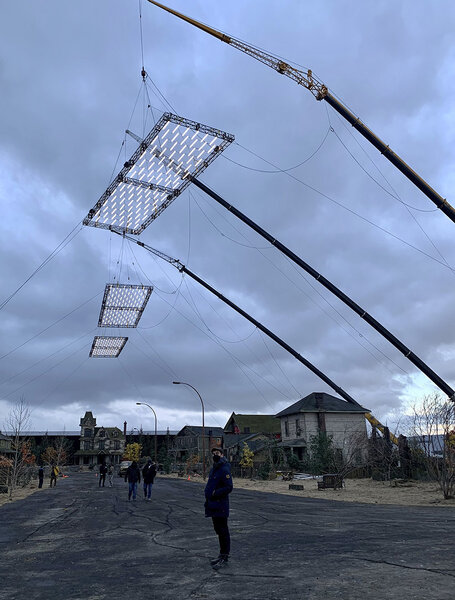
This was a very light configuration, that wasn’t very affected by the wind which could rush between the tubes, and which allowed us to shoot night scenes even with a wind gusting at nearly 90 km/h. The tubes are simple, two-tone lights made to resist the weather. From a special effects point of view, we really tried to do as much as possible live, leaving to digital effects only the things that we couldn’t do otherwise. The only thing that we hadn’t really planned for was snow, which caused us to lose a week of filming on this particular episode.
Another recurring type of scene in your episodes is that of underground explorations or very dark places...
EB : As a cinematographer, filming underground without proper lighting is always a headache. This type of sequence gave rise to a lot of discussions in preparation. So, most of the time we equip the actors with flashlights and other sources of light, but that can’t do everything. And this is where you have to find the right combination from movie lights. You cross your fingers and hope it doesn’t look too bright ! For this kind of scene, my favorite tool turned out to be a series of autonomous two-tone LED tiles (30/30cm). They’re extremely thin, and therefore very easy to hide almost anywhere you want on the location. By simply sticking them to the ceiling, for example, without any wiring constraints, it really became the ideal source for opening this or that part of the location, by adjusting them most of the time to just 1% on the dimmer ! That way, it gives just a very small level without it seeming like there’s a spot hidden in the image.
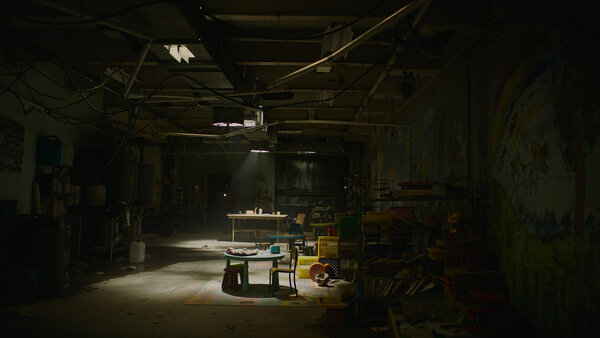
One of the locations that gave us a bit of a hard time was the old underground school where the characters briefly take refuge in episode five. On this location, it seemed essential to us to get away from the extremely claustrophobic atmosphere of the tunnels and everything that came earlier in their journey. To do that, we worked with the art director to find a justification for bringing in daylight. We did it through the ceiling vents. There, we were shooting on location, and the vents did not open to the outdoors. Thanks to the extreme thinness of my small LED plates, I was able to-insert them above the fans and thus give the impression that daylight was falling into the room. It’s not much, just a small effect, but it completely changes one’s perception of the decor, and it communicates, it seems to me, a little bit of warmth - almost comfort - in the middle of all this underground chaos.
What sequence are you most proud of ?
EB : I’d say the piano sequence in episode three. This is perhaps my favorite scene in the whole series. The kind of moment where, as a cinematographer, you realize that you have to sit in the passenger seat. In this sequence, the actors were able to sing and play the piano themselves. So, it was a bit like being in a configuration where you’re attending a live theatrical performance. Therefore, it seemed obvious to choose to shoot the entire thing in a single take with three cameras. This is where a less mature version of the DoP inside me suddenly said to himself "um... are three cameras really necessary ? It’s going to be really difficult to light properly !" Luckily, I had grown up in the meantime ! It’s clear to me that giving the actors priority was 100% the right decision.
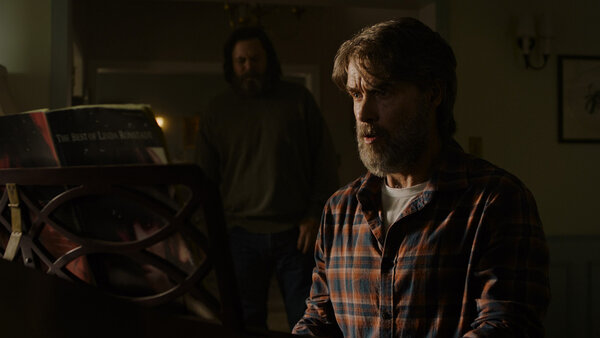
A word on color grading and finishing the series ?
EB : It was my first time working with Stephen Nakamura at Company 3 (Santa Monica). He’s a valuable asset. He is not only extremely fast, but he also suggests a lot of things on instinct that often end up paying off. It was amazing because we’d begin a color grading session with my explaining to him a scene’s ambience, and with a few clicks, he had already translated it on screen before I’d had time to finish my sentence !
From a general point of view, color grading of my episodes was rather rapid, in keeping with the concept of authenticity and simplicity that had guided us on the set. The final rendering is also quite close to what we’d get on set with our DIT.
If I had to draw some kind of analogy with the film days, I would say that nowadays, guys like Stephen are a bit like the reincarnation of my film emulsion. So many films are now shot with the same camera sensors, so for me it’s the colorist who is going to make that little difference in the end.
(Interview conducted by François Reumont, and translated from French by Alexander B. Raiffe for the AFC)
 En
En Fr
Fr


